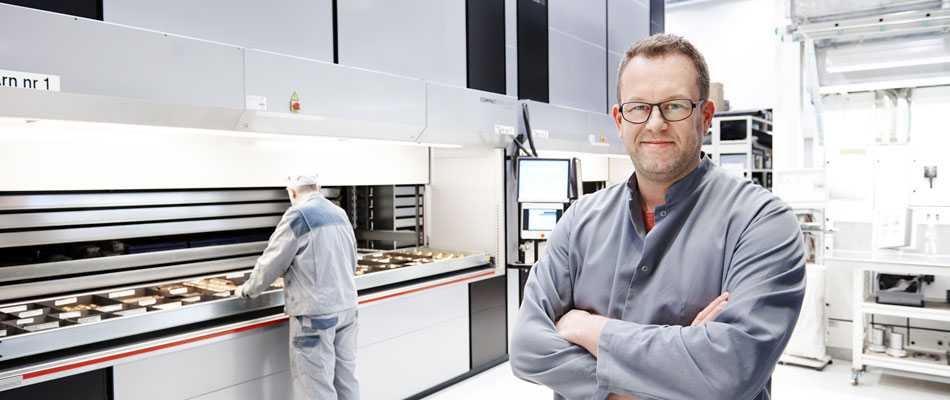Faerch: WMS manages self-service spare parts warehouse with vertical lifts
Faerch is Europe’s leading manufacturer of plastic packaging for ready-made meals. The company has its headquarters in Holstebro (DK) and factories in England and the Czech Republic. Faerch has a huge maintenance department consisting of about 20 smiths/repairmen, about 30 staff in charge of configuration, and an associated warehouse storing spare parts for production facilities. The spare parts warehouse is located near the production area and the production office. The need to expand the production office meant it was obvious to incorporate part of the premises, which the spare parts warehouse occupied, and continue to keep the warehouse near the production area.
The challenges
Consequently, they decided to explore the possibility of compressing the spare parts into a smaller area. That was a question of about 7,500 item numbers, which occupied an area of about 200 m2 of floor space in the premises, where the ground clearance to the ceiling was not being used. They also wanted to solve the challenges implicit in a spare parts warehouse, in which 50 users, divided into 5 shifts around the clock, personally must walk around to find the spare parts they need.
The challenges included:
- No/few permanent warehouse staff
- Only few people feeling responsible for order
- Slips indicating picked goods are not always completed
- Deviations in inventories
- Lack of warehouse management
- People must know where items are located
- A lot of time spent searching for the right items
- Expensive urgent deliveries
Solution
It was obvious that vertical storage lifts would be an ideal solution for the storage of spare parts, 85% of which were small parts, suitable for storage in an automated system. The remaining 15% or so were not suitable for vertical storage lifts. They would keep those in a small section of the existing manual shelves. These ‘dated’ small parts were known for their large volume and excessive weight, or there were consumables such as screws and bolts, picked at random and not controlled in terms of stock.
The spare parts could be consolidated in two 5.6-metre-high vertical storage lifts with a footprint of 24.5 m2. In total, including the working area around the vertical storage lifts and the manual warehouse, the warehouse now occupies a mere 90 m2. In other words, the company has saved more than 50% of its space.
To ensure maximum benefit of the capacity of the vertical storage lifts, the company decided to invest in a WMS to manage both the vertical storage lifts and the manual element of the warehouse.
Technology lightens the workload
Faerch is interested in working intelligently, right down to details such as the spare parts warehouse. The objective is to put all resources to maximum use: not by running faster, but by deploying smart technology. The mini project of the spare parts warehouse, where the technologies vertical storage lifts and WMS were used, is an excellent example of this. Here they have made optimum use of the available space. The man-hours of the smiths/repairers/configuration operators should be used correctly: not on hunting for spare parts. The searches are often unsuccessful and in critical situations they end up ordering items from outside at expensive prices, or paying for express delivery so they can have them in the warehouse the following day.
Self-service warehouse
Like other spare parts warehouses, Faerch is a support service for operations. Usually, there are no permanent or only a few warehouse employees attached to the warehouse, so users must go in and personally find the spare parts they need. This situation can be a challenge, which can be costly for the company and unsatisfactory for employees. But if you do things the right way, success is not impossible. At Faerch, the warehouse is staffed with 1 warehouse manager, who has overall responsibility for the warehouse and reordering and replenishment. About 50 users, who must serve themselves with spare parts as needed, use the warehouse. The ‘visits’ of individual employees to the warehouse fluctuate from day to day. Some days, an employee collects spare parts in the warehouse 3 or 4 times, whilst other days there are no ‘visits’ to the warehouse. At the same, picking from stock is not their main job. That is why the user interface must be clear and easy to use. LOGIA WMS has a very simple, graphic user interface, which is a great advantage, especially in a spare parts warehouse. It also guides users when picking and requests them to update the system.
The working day in the new warehouse
All locations, item numbers, and stocks are registered and controlled in LOGIA WMS. When commissioning LOGIA WMS, the basic master data on the spare parts were transferred from the previously used system and supplemented by additional data such as dimensions, photos/drawings of the spare parts, etc., and stockpiles were updated.
All picking in the warehouse start at the central warehouse PCs, where LOGIA WMS runs. Here you search for the spare parts you need. The Smith/configuration operator does not necessarily know the ID of the item to use when searching for the item. The search screen display allows users to search based on one or more different characteristics. This might be product group, item text, dimensions, material, relation to the facility structure/warehouse area, etc.
The search results are displayed in a list, in which the items are classified in descending order according to the number of search criteria satisfied. When you go through the list, you see every single spare part with associated data and a photo/drawing. The photo played an important role in the transition to the new solution. It means that you can quickly and easily recognize and trace an item in the system. You select the correct spare part and press the ‘Pick’ key on the screen. If the spare part is in the vertical storage lift, LOGIA WMS activates the shelf on which the item is located. On the other hand, if the spare part is in the manual warehouse, it indicates the rack, shelf, and location number together with a visual indication of where on the shelf you will find the product.
It is now easy to pick the actual spare parts in the desired number. Picking is not finished until the user has specified the number of items picked and confirmed it on the screen. An added feature at Faerch involves asking the user to indicate where in the facility structure the spare part is going to be used. LOGIA WMS automatically displays the structure of the facility, and then asks for the information, which the user can easily provide. This compilation of history provides knowledge, which can be used advantageously for making better decisions.
It is also easy to place items. You look up the item on the LOGIA search screen and press the ‘Placement’ key. If it is an existing item, the stock is updated with the current total, and the item is placed either on top of the existing stock or in a new location. Location and stock are automatically recorded in LOGIA, so the spare part can easily be found. If it is a new item, it is configured in LOGIA with master data. After that, the process is the same as for an existing item.
Layout of the vertical storage lifts
The vertical storage lifts contain a total of 110 shelves, all of which are subdivided into small areas appropriate for the goods to be stored on them. At Faerch it makes sense for the spare parts that belong to the same machine group or product group to be located on the same shelf. The items, which belong to the same machine group, are assembled on the same shelf/shelves. Items that are used across multiple machine groups are placed on the shelves based on product groups. This means that the user can generally find the related parts on the same shelf and thus should only need to activate a few shelves for picking multiple items. That means that picking can be done quickly and easily. In practical terms, the user finds and initiates the picking of a given spare part, picks the item and acknowledges receipt on the screen. The screen displays the shelf with the current space divisions and the user can then select the spaces s/he also needs to pick from and acknowledge the number of items s/he has picked one by one.
The advantage of the new warehouse setup
The spare parts warehouse has become much leaner and more manageable. In addition to the objectively excellent results, the new warehouse setup has had a positive effect on the employees’ attitude and approach to and satisfaction with working procedures in the warehouse. This has proved to have a huge impact on the workshop in the maintenance department. Here, the staff has taken the initiative to clear things up and keep a sense of order, so the working day has become easier and more attractive here as well.
“Our spare parts warehouse is used by about 50 repairmen divided into 3 shifts. They need to be able to find the parts they need at any time of the day. That is why we invested in LOGIA WMS and vertical storage lifts. The system is easy and extremely efficient.” Henrik Thomsen, Production Development Engineer, Faerch.
Read more about Faerch.













